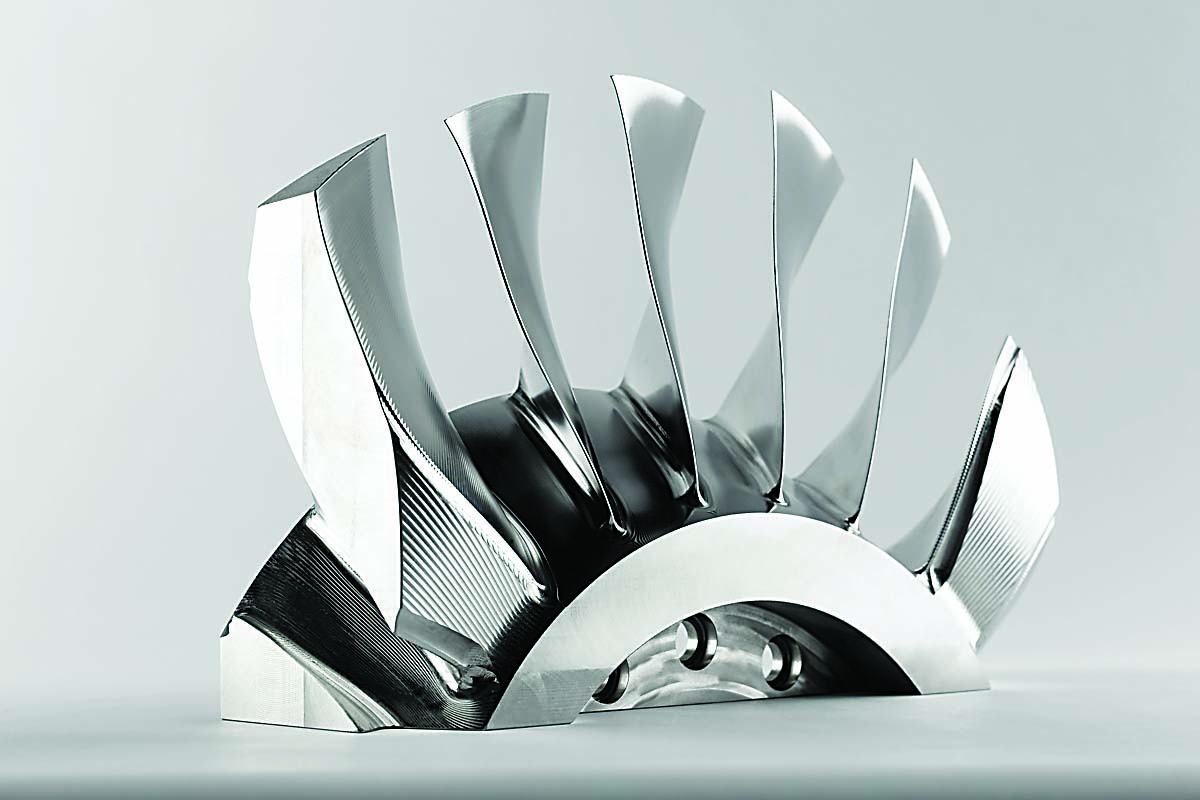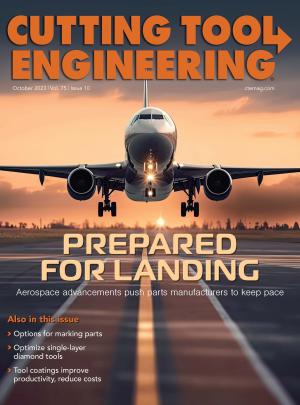By Eric Ostini, GF Machining Solutions
The aerospace industry always has tested its parts suppliers on their ability to machine difficult materials. Critical engine components and airframe structures require components that are light yet uncompromisingly strong and durable, and the exotic alloys and composites being developed are beginning to further challenge the limits of conventional machine technology and part processing methods.
Superalloys like Kovar and Inconel provide many benefits, but the high cutting forces required to machine them generate a tremendous amount of heat and workhardening. Moreover, Inconel and other superalloy chips are gummy and stick to virtually everything in a machining center. Composites, in addition to being extremely hard, are brittle and abrasive, requiring special cutting tools to avoid delamination and achieve desired surface finishes.
If those challenges aren’t enough, lower-tier manufacturers now face the aerospace OEMs’ proprietary black art of formulating aerospace materials that are unique creations and closely guarded business secrets. Operating within this highly secretive and competitive arena has a steep, expensive learning curve that limits the advance of generalized machining parameters for efficient production. In many cases, machining methods used on one formula of these cutting-edge substances do not apply to others.
Conventional milling that uses shearing and cutting forces to machine has been pushed hardest by the continual development of new component materials. Milling remains feasible for many components, such as landing gear assemblies, seats, interior fixtures and panels. However, critical high-stress parts like engine components demand near-perfect integrity devoid of microcracking caused by the high thermal forces of machining. This is why conventional machine shops often struggle to establish throughputs that are efficient and profitable while maintaining proper thermal conditions.
To keep pace, tooling suppliers have had to advance cutting tool technology. Little more than a decade ago, polycrystalline diamond tools were among the hardest tools available that also provided a high degree of abrasion resistance and tool life. The new generation of aerospace materials, unfortunately, quickly wore down PCD tooling to the extent that a single part required multiple tool changes to complete.

Today, conventional milling of complex aerospace parts calls for cutting tools sintered with manufactured diamonds in which the shape of the part being milled is engineered into tool geometry. While these advances solve some of the challenges of aerospace part machining, they are extremely expensive, and their cost effectiveness is not always clear. Further, the materials used in today’s aerospace sector are not only battering cutting tools but wearing out the machine tools. As a result, a growing number of aerospace part manufacturers have adopted other technologies like electrical discharge machining, laser machining and additive manufacturing.
Contactless Cutting
EDM has taken a leading role in many aspects of aerospace manufacturing. Because the EDM electrode never contacts the workpiece, precision seal slots and other high-tolerance features can be machined without imparting stress to the part. Overall, EDM’s ability to cut very hard materials and complex shapes without the thermal distortion associated with conventional machining has made it a chief technology in aerospace manufacturing. However, electrical discharge machine tool builders have had to work hard to adapt the technology to aerospace’s unique challenges.
Manufacturers like GF Machining Solutions LLC have worked for years to adapt machines and technology to the aerospace industry, specifically regarding machine generator settings to obtain the proper spark. Previously, spark energy ramped up slowly, plateaued and then diminished slowly. That long duration transferred too much heat into the workpiece, causing a loss of integrity and microcracking.
With EDM advancements and enhancements, the spark now is generated at its cutting temperature, which tapers off almost immediately. The spark cutting forces do not penetrate the workpiece deeply enough to affect its integrity, and the heat-affected zone is virtually eliminated. Additionally, advanced EDMs now generate 300,000 to 400,000 sparks per second directly at the cutting zone, whereas before only 80,000 to 100,000 sparks per second were achievable, increasing overall production efficiency.
Laser machining and laser micromachining are technologies finding an emerging position in aerospace manufacturing as well. Also able to machine with a minimal to no heat-affected zone,micromachining laser sources, for instance, provide repeatability, precision and accuracy for delicate parts with complex shapes, especially when micron-sized features are involved. Many aerospace components now are being coated with ceramics, and manufacturers are discovering that laser machining brings precision and efficiency to cutting hard ceramic. Compared with EDM, lasers can remove nonconductive materials, such as ceramics, and use no consumables.
Although additive manufacturing is finding its niche in the aerospace sector, the process is by no means the comprehensive solution to all of that industry’s challenges. Currently, it is used mostly for parts with ribbed or hollow pockets, such as components for seats and fuselage framing. While some aerospace OEMs are producing critical high-strength parts like jet engine components via additive manufacturing, at present the process is unable to produce such parts fast enough to make the application profitable or even cost-effective.
Pushing the Envelope
Regardless of the machining technology used, aerospace has forced manufacturers in many cases to develop machines and processes specifically dedicated to the sector. In addition to material composition requiring machine technology to adapt, component shape/design can be a significant challenge. Unique shapes, such as blisk airfoils and thin-walled parts, require special workpiece holding solutions or modifications to the machine cutting/machining envelope to accommodate complex designs.
Additionally, aero-systems design — engines, airframes, wings, etc. — continues to push the manufacturing envelope with demands for quieter, longer and more efficient performance with no single process adequately meeting the industry’s myriad of needs. Manufacturers are compelled to employ a variety of processes in production runs, but that kind of versatility requires a tremendous amount of diversified expertise that many shops simply do not have and cannot acquire at a reasonable cost.
As a result, the sector is spawning specialized enterprises that provide comprehensive solutions to shops for aerospace and other advanced manufacturing. GF Machining Solutions’ Liechti Engineering group, for example, determines an entire part production process, including the appropriate production technology, machine settings, programs and application methods. These turnkey packages also include proof of process, operator documentation and even maintenance schedules. The high cost of process development with exotic and obscure materials, paired with advanced machining and zero tolerance for error, in many cases justifies manufacturer reliance on a company that can supply the most efficient, cost-effective part production method.
Ultimately, aerospace parts manufacturers have found themselves chasing the ongoing developments in materials and technology of the industry itself. To keep from being outpaced by these advances, they are forced to employ every tool at their disposal for the part accuracy and integrity required by the sector while maintaining an acceptable throughput that makes the process efficient. Finding and keeping that balance will be critical to future success.
about the author: Eric Ostini is head of business development for North and Central America at GF Machining Solutions LLC. For more information, call 800-282-1336 or visit www.gfms.com.
Contact Details
Related Glossary Terms
- abrasive
abrasive
Substance used for grinding, honing, lapping, superfinishing and polishing. Examples include garnet, emery, corundum, silicon carbide, cubic boron nitride and diamond in various grit sizes.
- alloys
alloys
Substances having metallic properties and being composed of two or more chemical elements of which at least one is a metal.
- ceramics
ceramics
Cutting tool materials based on aluminum oxide and silicon nitride. Ceramic tools can withstand higher cutting speeds than cemented carbide tools when machining hardened steels, cast irons and high-temperature alloys.
- composites
composites
Materials composed of different elements, with one element normally embedded in another, held together by a compatible binder.
- conventional milling ( up milling)
conventional milling ( up milling)
Cutter rotation is opposite that of the feed at the point of contact. Chips are cut at minimal thickness at the initial engagement of the cutter’s teeth with the workpiece and increase to a maximum thickness at the end of engagement. See climb milling.
- electrical-discharge machining ( EDM)
electrical-discharge machining ( EDM)
Process that vaporizes conductive materials by controlled application of pulsed electrical current that flows between a workpiece and electrode (tool) in a dielectric fluid. Permits machining shapes to tight accuracies without the internal stresses conventional machining often generates. Useful in diemaking.
- gang cutting ( milling)
gang cutting ( milling)
Machining with several cutters mounted on a single arbor, generally for simultaneous cutting.
- heat-affected zone
heat-affected zone
That portion of the base metal that was not melted during brazing, cutting or welding, but whose microstructure and mechanical properties were altered by the heat.
- laser machining
laser machining
Intensified, pulsed beams of light generated by lasers—typically carbon dioxide or neodium-doped yttrium aluminum garnet (Nd:YAG)—that drill, weld, engrave, mark, slit and caseharden. Usually under CNC, often at both high cutting rates (100 linear in./sec.) and high power (5kW or more). Lasers also are used in conjunction with in-process quality-control monitoring systems allowing measuring accuracies of 0.00001".
- machining center
machining center
CNC machine tool capable of drilling, reaming, tapping, milling and boring. Normally comes with an automatic toolchanger. See automatic toolchanger.
- milling
milling
Machining operation in which metal or other material is removed by applying power to a rotating cutter. In vertical milling, the cutting tool is mounted vertically on the spindle. In horizontal milling, the cutting tool is mounted horizontally, either directly on the spindle or on an arbor. Horizontal milling is further broken down into conventional milling, where the cutter rotates opposite the direction of feed, or “up” into the workpiece; and climb milling, where the cutter rotates in the direction of feed, or “down” into the workpiece. Milling operations include plane or surface milling, endmilling, facemilling, angle milling, form milling and profiling.
- polycrystalline diamond ( PCD)
polycrystalline diamond ( PCD)
Cutting tool material consisting of natural or synthetic diamond crystals bonded together under high pressure at elevated temperatures. PCD is available as a tip brazed to a carbide insert carrier. Used for machining nonferrous alloys and nonmetallic materials at high cutting speeds.
- polycrystalline diamond ( PCD)2
polycrystalline diamond ( PCD)
Cutting tool material consisting of natural or synthetic diamond crystals bonded together under high pressure at elevated temperatures. PCD is available as a tip brazed to a carbide insert carrier. Used for machining nonferrous alloys and nonmetallic materials at high cutting speeds.
- superalloys
superalloys
Tough, difficult-to-machine alloys; includes Hastelloy, Inconel and Monel. Many are nickel-base metals.
- tolerance
tolerance
Minimum and maximum amount a workpiece dimension is allowed to vary from a set standard and still be acceptable.
- workhardening
workhardening
Tendency of all metals to become harder when they are machined or subjected to other stresses and strains. This trait is particularly pronounced in soft, low-carbon steel or alloys containing nickel and manganese—nonmagnetic stainless steel, high-manganese steel and the superalloys Inconel and Monel.


